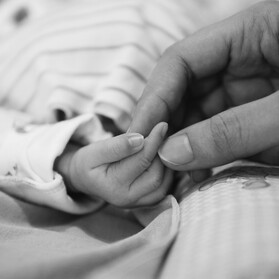
Parental leave explained
Congratulations! Exciting times ahead for you and your whānau. When applying for parental leave, you want to make sure all the boxes have been ticked so that when your pēpē arrives everything is sorted.
We’ve put this resource together to help answer some of the questions RMOs have when applying for Parental leave. Whether you’re going to be the main caregiver or just need a few weeks off, it’s important to know what you’re entitled to, and how to apply. Check out the Parental Leave Best Practice Guidelines and the STONZ national manual. If you still have questions, please get in touch, our team is happy to help.



Your Parental Leave questions answered
What is the eligibility criteria for Parental Leave?
Parental Leave is up to a maximum of 52 weeks (12 months service) or 26 weeks (6 months service) shared between both partners. This excludes any period of partners leave:
The primary carer is entitled to 26 weeks of primary carer leave.
From 1 March 2021, if the primary carer leave starts early (by medical or employer direction as above), the female employee giving birth may still take at least 20 weeks’ primary carer leave after the expected date of delivery birth (even if this means that she will have taken more than 26 weeks primary carer leave). In this situation, the additional weeks of primary carer leave are not included in the calculation of the amount of extended leave available.
Extended leave is a period of either 26 or 52 weeks’ leave. It may be taken in more than one continuous block if the employer and employee agree. Any primary carer leave taken will reduce the number of weeks that can be taken as extended leave. As an example, if the employee is entitled to 52 weeks of extended leave and takes 26 weeks of paid primary carer leave, they will have a remaining 26 weeks of extended leave available to take.
Extended leave can be taken by either or both partners (depending on eligibility) up to the maximum entitlement (dependent on length of service – see table below).
Extended leave can be taken in any period or periods, up to the maximum entitlement, between the applicable start date and the applicable end date.
Employment New Zealand - Parental Leave and Payment Eligibility table
What is the difference between primary and non-primary caregiver?
Primary caregiver: The Primary Caregiver can be either:
The mother who is pregnant or giving birth to a child;
The spouse/partner of the biological mother if the mother has transferred her entitlement;
is the person who takes permanent primary responsibility for the care, development and upbringing of a child who is under 6 years of age.
Non-primary caregiver: The non-primary Caregiver is the partner/spouse of the primary carer.
What am I entitled to as a primary caregiver?
The primary caregiver is eligible for a paid parental leave top up for 14 weeks. This is the difference between the statutory payment and the equivalent weekly value of the employee’s base salary (prorata if less than full time).
This is in addition to the IRD Statutory Parental Leave Payments. If you’re an employee, to get parental leave payments you must:
be going to be the primary carer of a child under 6 years (through giving birth or otherwise taking permanent primary responsibility for the care, development and upbringing of the child, eg through adoption, and
have been employed as an employee (this doesn’t have to be for the same employer) for at least an average of 10 hours per week over any 26 of the 52 weeks just before: - the baby’s due date (if the child is being born to you or your spouse or partner), or - in any other case of a child under 6 years, the date when you or your spouse or partner becomes the primary carer of the child.
How is the primary caregiver payment calculated?
To be eligible for the ‘top up’ payment the employee must be in receipt of the IRD payment.
Provided that this criteria is meet then the 14-week top up is paid; is the difference between the statutory payment and the equivalent weekly value of the employee’s base salary (prorata if less than full time).
The payments shall start at the commencement of the parental leave and shall be calculated at the ordinary rate (pro rata if appropriate) applicable to the employee immediately prior to commencement of parental leave. Except where an employee, on medical advice and with the consent of the employer, elects to work reduced hours at any time prior to the taking of leave, then the calculation of payment for the parental leave shall be based on the proportion of full-time employment immediately prior to any such enforced reduction in hours.
It is important for RMOs to remember that they need to apply to the IRD for the government paid parental leave, as well as parental leave from their employer. This IRD process is managed on line via the myIR login on the IRD website.
What am I entitled to as a non- primary caregiver?
An employee, who is not the primary care giver, shall be granted paid partners leave of up to two weeks on their ordinary salary and subject to meeting the eligibility criteria, up to two weeks unpaid partner’s leave under Part 2 of the Parental Leave and Employment Protection Act 1987.
Yes, you are eligible for both where you meet the criteria set out in the Act;
Where you meet the six month criteria you may take one week of unpaid partner’s leave under the Act
Where you meet the twelve month criteria you may take two weeks of unpaid partner’s leave under the Act.
Can I still access reimbursements for training expenses, employment expenses and CME while on Parental Leave?
Yes! You are still entitled to all your normal collective agreement provisions while on parental leave.
As the non-primary caregiver am I able to take my 2 week entitlement in sections, maybe one week at a time?
Yes, you can take this in two separate week long blocks and it must be taken within three weeks prior to the delivery date or adoption, or within three weeks after the date of delivery or adoption.
Variations to the date in which this leave is taken may be agreed by the district and the RMO.
What notice do I need to give my employer that I am taking parental leave?
The employee must give a minimum of three months written notice to the employer prior to the expected date of delivery. Such notice shall contain a certificate from their medical practitioner or LMC stipulating that the employee or the employee’s partner is pregnant and the expected date of delivery. The notice shall also stipulate the period for which the employee is seeking to take as leave.
If the employee is adopting a child whose age is less than five then the employee must notify the employer of such and their intention to take parental leave within fourteen days of receiving notification of the adoption or placement of the child to them. Note: this does not require the employee to give a minimum notice of their intention. Notice of actual placement and the need to commence parental leave may be less than two weeks.
In both such instances the employee must provide the date of delivery or adoption and the period for which the employee is seeking to take as leave. Date of return that he or she intends to return to their employment.
(Generally, any early return to workplace or any change to the terms and conditions of employment on the return to workforce must be with the agreement of both employer and employee.)
What are the obligations of employee?
You will need to complete the IRD paperwork via the myIR login as part of your parental leave application. Whilst district processes may differ it is the individual’s responsibility to ensure that this paperwork is submitted to the IRD within the required timeframe.
What are the obligations of employer?
Within 3 weeks of receiving an application for parental leave the employer will notify in writing the employee of their entitlement to parental leave and whether their position will be kept open.
Subject to the position not being both a key position and one which is not practical to employ someone on a fixed term agreement as a replacement, then the employer shall keep the employee’s position open for them on their return to work.
Recognise the employee’s service as being continuous on their return to work.
Ensure the employee’s terms and conditions remain the same.
Breastfeeding and facilities
The employing districts are responsible for ensuring that any RMO who wishes to continue their breast-feeding journey on their return to work are strongly supported to do so including;
Ensuring appropriate breaks are provided to an RMO who is breastfeeding and wishes to breastfeed during work.
Ensuring appropriate facilities are provided in the workplace for an RMO who is breastfeeding and who wishes to breastfeed in the workplace and that these facilities are within a reasonable distance of the RMOs workplace i.e., accessible (and near acute services if applicable) with access to refrigeration facilities.
If the above cannot be provided, then the district will agree with the RMO what other support may be provided including reimbursement (in part or in full) of a portable/wearable breast pump so RMOs can continue to breast feed and work.
What are the limits on hours for pregnant employees?
Limits on Hours for Pregnant employees. Employees shall be able to reduce hours of work as follows:
(a) From 28 weeks of pregnancy (or earlier if medically advised by the employee’s lead maternity carer), no night shifts shall be worked.
(b) From 32 weeks of pregnancy (or earlier if medically advised by the employee’s lead maternity carer), no long days more than 10 hours shall be worked.
(c) From 36 weeks of pregnancy (or earlier if medically advised by the employees lead maternity carer), no acute clinical workload shall be allocated. 28.4.1 Employees reducing hours as provided for in this clause above shall have their salary reduced in a manner to reflect their reduced workload in accordance with what would have been their expected roster but for the pregnancy.
Note this is a guideline and not a requirement at the discretion of the employee. The employer may drop the employee’s salary in accordance with the reduction in hours worked.
Do I accrue annual leave on parental leave?
Yes, you will continue to accrue leave based on the FTE you are employed on at the time you take parental leave.
However, once you return from parental leave (any leave that wasn't entitled before your left) will be paid at the average weekly earnings rate for a period of 12-months. I.e there is no comparison to your ordinary weekly earnings for the 12-months after your return from parental leave.
Is there any leave available while I’m pregnant to attend appointments?
You can get up to 10 days unpaid special leave when you’re pregnant. This is for medical appointments, scans, antenatal classes — it does not have to be taken as a full day’s leave.
Can primary caregiver parental leave be shared?
Yes, in certain situations there is the ability to sharing the Primary Care Giver Responsibilities. The most common example of this happens is where, the father is employed as an RMO by Te Whatu Ora and the mother is not a Te Whatu Ora employee.
The Parental leave Act provides that if two people meet the criteria for paid parental leave, they must nominate one of them to receive the payment. However, by assuming responsibility for day to day care of the child, in the situation above the father can become eligible for the statutory payment (and therefore for the collective agreement top up). However, s71J says that the payment can only be made for one continuous period per person – so the father would have to take the first period (i.e. the first 14 weeks) and then switch it to the mother after such time. If this is something you are considering you need to ensure that:
The mother has completed the application for Paid Parental Leave Transfer via myIR because both parents will be sharing the Government funded paid leave.
Over that period of parental leave as the primary carer each parent has been approved the statutory IRD payment.
The father has provided a copy of the letter from the IRD to the district confirming the dates he will be in receipt of the statutory IRD payment. At least 3-months’ notice has been provided to the district and all necessary forms have been filled in.
Limits on hours for returning from Parental Leave
Where requested RMOs should not be rostered for any long days, weekends or nights in their first month after returning from parental leave.
Office Hours
Our normal office hours are 9am - 4.30pm, Monday to Friday.
If we don't answer straight away please leave a message and we will return your call ASAP.
Contact us
Please get in touch with any questions you may have. We would love to hear from you.
E: support@stonz.co.nz
P: 03 745 9258
PO Box 22656, Christchurch 8140
HOME | ABOUT STONZ | WHO WE ARE | SECA | TRAINEE INTERNS | RESOURCES | JOIN STONZ | Join us on Facebook



